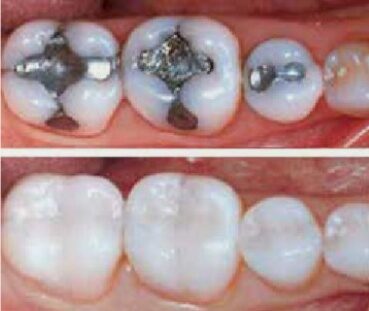Amalgam “silver” fillings have been used in the dental industry since the 19th century and are still used every year in the United States by thousands of dentists. It’s been estimated by the U.S. Food and Drug Administration (FDA) that more than one billion amalgam fillings were placed in mouths between 1988 and 2008. They are widely used because they are strong and provide a strong chewing surface; plus, they can easily be inserted quicker than other types of fillings, which is helpful when treating children. Additionally, they are affordable and are long lasting.
Dental amalgams are said to contain approximately 43-54% of mercury and the rest is made from silver, copper and tin. The concern with using the amalgams stems from the vapor being released in small amounts, and then absorbed by the body either through ingestion or inhalation. Everyday activities like chewing gum, brushing teeth, and chewing food contribute to the mercury emission from the fillings which can then lead to a build-up of toxins in the body. These emission build-ups have been found in the brain, adrenal glands, pituitary glands and other parts of the body, all of which have been linked to a number of health complications and diseases.
Although silver fillings are still commonly used by many dentists today, there are now alternatives, one of them being, composite filling restorations. The use of composite fillings bypasses the risks associated with amalgam altogether. Composite fillings are made-up of a glass and plastic mixture that is not toxic to the human body, making it the safe substitute for amalgam fillings.
Composite fillings are durable, and over time they conserve more of the natural tooth, whereas amalgam has been said to weaken the structure of the tooth and cause cracks. Developed in the 1980’s, composite fillings have quickly gained popularity and are more commonly preferred.
Because it can be color matched to a person’s teeth, there are multiple uses, such as repairing chipped, broken or worn teeth, shaping of disfigured teeth, and other cosmetic improvements of the smile; all of which would not be repairable by amalgam fillings. Composite restorations are conservative, meaning a less invasive procedure. With composite restorations, we are able to do less drilling, retaining more of the tooth structure than with previously used materials. Composites bond to the tooth to support the remaining tooth structure, which helps to prevent breakage, minimize leakage and insulate the tooth from excessive temperature changes. The composite material is durable and able to withstand chewing pressure.
Dr. Reilly uses local anesthetic to provide pain free removal of mercury fillings. He uses tooth isolation (dental dam), super high speed suction, and surgical mask to safely remove fillings and prevent further toxicity. Once all amalgam is removed, dam is removed, gloves are changed and teeth are restored using a BPA free composite filling that will match existing tooth color. Where crowns are needed, he will only place zirconia crowns.
Dr. Reilly’s office uses digital x-rays that are up to 70% less radiation, along with state-of-the-art sterilization. Schedule your FREE consultation today! Call: 248-835-6039
Dr. Tim Reilly graduated from U of D Mercy in 1996, with his undergraduate from Eastern Michigan University. His Bloomfield Hills practice of 19 years focuses on family, cosmetic, and implant dentistry with a holistic approach. He has helped many patients become mercury free using a conservative approach as well as digital x-rays for minimal radiation.
Dr. Tim Reilly











